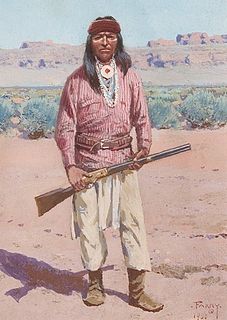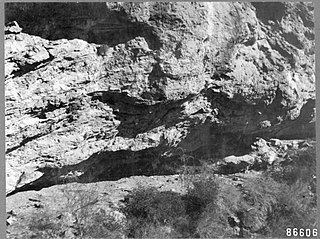
An Apache scout is a member of an Apache tribe who is trained in reconnaissance, either for hunting, defense of the people, or during times of war. [1]

An Apache scout is a member of an Apache tribe who is trained in reconnaissance, either for hunting, defense of the people, or during times of war. [1]
Only Lipan, Chiricahua and Mescaleros have, or have historically had, scout societies. The scouts' original purpose was to protect the people in their clan from enemies, to locate game and new campsites. This traditional role in community is different from that of the military scouts hired by the United States Army during the Indian Wars.[ citation needed ]
Scouts traditionally train in an intense process that can last over ten years. Traditional skills to be mastered include tracking and hunting, wilderness survival, and cultural knowledge unique to their particular band.[ citation needed ]

The Pawnee are a Central Plains Indian tribe that historically were based in Nebraska and Kansas and currently are based in Oklahoma. Today they are the federally recognized Pawnee Nation of Oklahoma, who are headquartered in Pawnee, Oklahoma. Their Pawnee language belongs to the Caddoan language family, and their names for themselves is Chatiks si chatiks or "Men of Men".

Geronimo was a prominent leader and medicine man from the Bedonkohe band of the Apache tribe. From 1850 to 1886, Geronimo joined with members of three other Chiricahua Apache bands—the Tchihende, the Tsokanende and the Nednhi—to carry out numerous raids, as well as fight against Mexican and U.S. military campaigns in the northern Mexico states of Chihuahua and Sonora and in the southwestern American territories of New Mexico and Arizona. Geronimo's raids and related combat actions were a part of the prolonged period of the Apache–United States conflict, which started with American settlement in Apache lands following the end of the war with Mexico in 1848.

The Lenape, also called the Leni Lenape, Lenni Lenape and Delaware people, are an indigenous people of the Northeastern Woodlands, who live in the United States and Canada. Their historical territory included present-day New Jersey and eastern Pennsylvania along the Delaware River watershed, New York City, western Long Island, and the Lower Hudson Valley. Today, Lenape people belong to the Delaware Nation and Delaware Tribe of Indians in Oklahoma; the Stockbridge-Munsee Community in Wisconsin; and the Munsee-Delaware Nation, Moravian of the Thames First Nation, and Delaware of Six Nations in Ontario.
Scout may refer to:
The Apache are a group of culturally related Native American tribes in the Southwestern United States, which include the Chiricahua, Jicarilla, Lipan, Mescalero, Mimbreño, Ndendahe, Salinero, Plains and Western Apache. Distant cousins of the Apache are the Navajo, with which they share the Southern Athabaskan languages. There are Apache communities in Oklahoma, Texas, and reservations in Arizona and New Mexico. Apache people have moved throughout the United States and elsewhere, including urban centers. The Apache Nations are politically autonomous, speak several different languages and have distinct cultures.

Mescalero or Mescalero Apache is an Apache tribe of Southern Athabaskan Native Americans. The tribe is federally recognized as the Mescalero Apache Tribe of the Mescalero Apache Reservation, located in south central New Mexico.

The Western Apache live primarily in east central Arizona, in the United States. Most live within reservations. The Fort Apache Indian Reservation, San Carlos Apache Indian Reservation, Yavapai-Apache Nation, Tonto Apache, and the Fort McDowell Yavapai Nation are home to the majority of Western Apache and are the bases of their federally recognized tribes. In addition, there are numerous bands. The Western Apache bands call themselves Ndee (Indé) ; because of dialectical differences the Pinaleño/Pinal and Arivaipa/Aravaipa bands of the San Carlos Apache pronounce the word Innee or Nnēē:.

Jicarilla Apache, one of several loosely organized autonomous bands of the Eastern Apache, refers to the members of the Jicarilla Apache Nation currently living in New Mexico and speaking a Southern Athabaskan language. The term jicarilla comes from Mexican Spanish meaning "little basket", referring to the small sealed baskets they used as drinking vessels. To neighboring Apache bands, such as the Mescalero and Lipan, they were known as Kinya-Inde . The Jicarilla called themselves also Haisndayin translated as "people who came from below", because they believed themselves to be the sole descendants of the first people to emerge from the underworld, the abode of Ancestral Man and Ancestral Woman, who produced the first people.

Plains Indians or Indigenous peoples of the Great Plains and Canadian Prairies are the Native American tribes and First Nation band governments who have historically lived on the Interior Plains of North America. While hunting-farming cultures have lived on the Great Plains for centuries prior to European contact, the region is known for the horse cultures that flourished from the 17th century through the late 19th century. Their historic nomadism and armed resistance to domination by the government and military forces of Canada and the United States have made the Plains Indian culture groups an archetype in literature and art for Native Americans everywhere.

The Apache Wars were a series of armed conflicts between the United States Army and various Apache nations fought in the southwest between 1849 and 1886, though minor hostilities continued until as late as 1924. The United States inherited conflicts between American settlers and Apache groups when Mexico ceded territory after the Mexican–American War in 1846. These conflicts were continued as new United States citizens came into traditional Apache lands to raise livestock, crops and to mine minerals.

The First Battle of Adobe Walls was a battle between the United States Army and American Indians. The Kiowa, Comanche and Plains Apache tribes drove from the battlefield a United States Expeditionary Force that was reacting to attacks on white settlers moving into the Southwest. The battle, on November 25, 1864, resulted in light casualties on both sides but was one of the largest engagements fought on the Great Plains.
The Tonto Apache is one of the groups of Western Apache people. The term is also used for their dialect, one of the three dialects of the Western Apache language. The Chiricahua living to the south called them Ben-et-dine or binii?e'dine'. The neighboring Western Apache ethnonym for them was Koun'nde, from which the Spanish derived their use of Tonto for the group. The kindred but enemy Navajo to the north called both the Tonto Apache and their allies, the Yavapai, Dilzhʼíʼ dinéʼiʼ – “People with high-pitched voices”).
The Navajo are a Native American people of the Southwestern United States.

The Fort Apache Indian Reservation is an Indian reservation in Arizona, United States, encompassing parts of Navajo, Gila, and Apache counties. It is home to the federally recognized White Mountain Apache Tribe of the Fort Apache Reservation, a Western Apache tribe. It has a land area of 2,627 square miles (6,800 km2) and a population of 12,429 people as of the 2000 census. The largest community is in Whiteriver.

The Apache Scouts were part of the United States Army Indian Scouts. Most of their service was during the Apache Wars, between 1849 and 1886, though the last scout retired in 1947. The Apache scouts were the eyes and ears of the United States military and sometimes the cultural translators for the various Apache bands and the Americans. Apache scouts also served in the Navajo War, the Yavapai War, the Mexican Border War and they saw stateside duty during World War II. There has been a great deal written about Apache scouts, both as part of United States Army reports from the field and more colorful accounts written after the events by non-Apaches in newspapers and books. Men such as Al Sieber and Tom Horn were sometimes the commanding officers of small groups of Apache Scouts. As was the custom in the United States military, scouts were generally enlisted with Anglo nicknames or single names. Many Apache Scouts received citations for bravery.

Shalako is a British-German 1968 Western film directed by Edward Dmytryk and starring Sean Connery and Brigitte Bardot. It was shot at Shepperton Studios near London with sets designed by the art director Herbert Smith. Location shooting took place in Almería in southern Spain, particularly in the Tabernas Desert which was frequently used in European westerns during the decade.
The Fort Sill Apache Tribe is the federally recognized Native American tribe of Chiricahua Warm Springs Apache in Oklahoma.

The Battle of Cibecue Creek was an engagement of the Apache Wars, fought in August 1881 between the United States and White Mountain Apaches in Arizona, at Cibecue Creek on the Fort Apache Indian Reservation. After an army expedition of scouts, U.S. Army soldiers 'arrested' a prominent Cibecue Apache medicine man named Nock-ay-det-klinne. The U.S. Army soldiers were taking Nock-ay-det-klinne back to the fort when they were ambushed by Apache warriors. During the conflict, the U.S. Army soldiers killed Nock-ay-det-klinne. Most of the 23 Apache scouts mutinied, in the largest such action of its kind in U.S. history. The soldiers retreated to Fort Apache. The following day, the White Mountain Apache mounted a counter-attack. The events sparked general unrest and led to White Mountain Apache warriors leaving the Fort Apache Indian Reservation to join forces with the Apache leader of the Bedonkohe band of Chiricahua Apache named Goyahkla, better known as Geronimo.

The Yavapai Wars, or the Tonto Wars, were a series of armed conflicts between the Yavapai and Tonto tribes against the United States in Arizona. The period began no later than 1861, with the arrival of American settlers on Yavapai and Tonto land. At the time, the Yavapai were considered a band of the Western Apache people due to their close relationship with tribes such as the Tonto and Pinal. The war culminated with the Yavapai's removal from the Camp Verde Reservation to San Carlos on February 27, 1875, an event now known as Exodus Day.

The Apache–Mexico Wars, or the Mexican Apache Wars, refer to the conflicts between Spanish or Mexican forces and the Apache peoples. The wars began in the 1600s with the arrival of Spanish colonists in present-day New Mexico. War between the Mexicans and the Apache was especially intense from 1831 into the 1850s. Thereafter, Mexican operations against the Apache coincided with the Apache Wars of the United States, such as during the Victorio Campaign. Mexico continued to operate against hostile Apache bands as late as 1915.